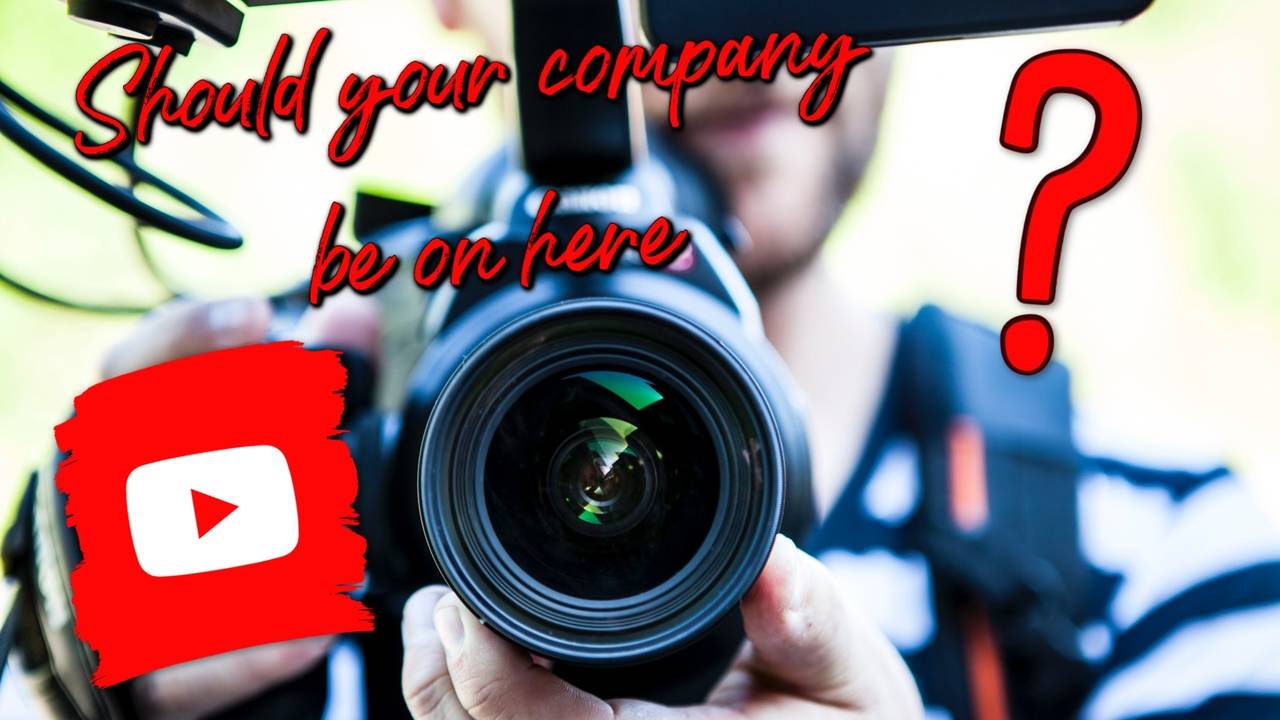Should My Company Use YouTube? If We Do How Can It Be Effective?

Expanding the scope of marketing has increasingly become internet-centric over the past 20 years.
Starting with basic e-mail outreach, we have reached an era of social media becoming one of the most effective ways of targeting your audience.
And although placing banners on smaller websites, blog promotion, or even sponsoring Tweets can be effective, there is another option you may have yet to consider.
Aside from more limited forms of social media like Twitter and Instagram, YouTube is gaining traction as a more well-rounded platform for marketing. Creating content, sponsored videos, and interlaced ads are all outlets to grow your company.
Below we will break down the essentials of YouTube and how you can implement this website into your business model.
YouTube Site History
Founded in 2005, the platform was originally used as a simple video sharing service. Homemade videos were being shared between friends, or more broadly, to the small audience on the site at the time.
However, site traffic has exponentially grown over the 15 years since its inception, making it one of the most visited sites on the internet.
There are, on average, two billion logged-in users on the site monthly, with a whopping five billion video views every single day.
As the second most trafficked website in the world, clearly, the marketing potential shouldn't be ignored.
Why You Should Use It
Obviously, the platform garners unparalleled traffic daily, but why should you make use of it in your day-to-day business? Here are some of the key benefits when you expand your marketing to this website.
Reaching Your Target Audience
Being able to market directly to your target audience is the dream of any company. Advertising can sometimes feel like a shot in the dark, never truly knowing if you are reaching potential customers.
The benefit of marketing on a website with immense traffic is the blanket coverage across various age groups, genders, and ethnicities.
73% of all adults in the United States visit the site, with over 80% of the 15-25 age group being active users.
While these numbers are staggering, American users only make up 20% of the visitors, highlighting the reach worldwide.
However, the most important number to take away is 51% of the users who visit daily, meaning regular exposure to the same audience.
Because this platform has become a ubiquitous form of entertainment, the ability to reach potential customers is only strengthened by their growing viewership.
Social Media Interconnectivity
Finding synchronicity among your various social media accounts can easily bolster your sales. Being able to share promotional videos via Twitter or Instagram can unify your various audiences across different platforms.
This not only increases overall exposure but allows for uniform growth across your online presence.
Having a one-track mind when it comes to marketing is never a successful gameplan, so the same should hold true when it comes to your social media accounts.
Direct Audience Interaction
As with all social media accounts, the "social" aspect is the unique advantage when marketing online.
While the conversation is the backbone of a website like Twitter, the interaction here can be just as beneficial.
Finding out what resonates with your target audience through the comment section of a video is a fantastic tool. Being able to respond to comments strengthens the relationship between your brand and the customers.
It is also a great barometer to figure out what is striking a chord and what is floundering.
A more blunt form of this comes with the "likes" and "dislikes" rating system on the video. The more likes, the stronger the support behind your brand.
Creating Your Own Video Advertisements
The ability to circumvent the traditional formats of advertisement can be a great tool for small businesses.
Because this is a free platform, the barrier for entry is much lower than the old school media.
If you can gain the same exposure from the internet that you can from a TV advertisement, why bother paying for placement on the channel?
Combined with the evergreen nature of your videos being omnipresent, it's a no brainer that using this platform to release standard advertisements is a great tool.
These ads can be placed on your personal website or shared across your other forms of social media.
Product Announcements
Perhaps you are a small business, and you have just come out with the newest version of your gadget.
You haven't quite gotten off the ground financially, but you believe this could be your breakthrough product.
How do you get the message out about this new product if you can't afford a televised advertisement? Or even a page in the local paper?
As mentioned before, posting online is as inexpensive as the cost of producing the video.
No fees or extra overhead costs are necessary when using social media to share your content.
You can build excitement and hype around an upcoming product without the risk of spending an excessive amount of your budget on product placement through more standard forms of media.
Product Reviews
Similar to product announcements, you can also review your existing brand and explain the benefits to potential clients.
Explaining your companies services or breaking down the features on a product can act as a one size fits all sales pitch.
This is also a great tactic for upselling existing clients to a new version of your product.
Comparing and contrasting the changes you've made on your new product is much more effective than the basic information they will gather from your tagline or an outside review.
Acting as a catalog for all of your products, potential customers will be able to scroll through all the different videos posted to understand the scope of your company.
Generating Extra Income

Because of the social nature of these online platforms, sometimes being less on the nose about your products and services can generate more interest.
This could mean simply providing entertaining content and then reaping the benefits of ad revenue off those videos.
Discussing Your Niche
Sometimes potential clients will simply be interested in your field of work, so being able to fill the gap of knowledge is an easy source of content.
For instance, if you are a personal trainer who is looking to expand their client base, talking about health and fitness topics can garner a large audience without the need to "pitch" your services.
Obviously, you could simply treat this as a built-in advertisement, but straying away from that and generating ad revenue can also be a great side source of income.
Earning approximately $2 per 1000 views, consistent content that has viral potential can be a great source of income.
Consumers are savvy in determining what an advertisement is and what is purely for entertainment purposes. But it doesn't mean you can't walk the fine line of both.
Highlighting the Benefits of Your Product
While directly advertising your product will prevent you from earning ad revenue on your videos, talking about the benefits of said product can be a way to circumvent that issue.
For instance, if you are a massage therapist looking to generate ad revenue, you can talk broadly about the benefits of massage therapy.
Making sharable content that avoids directly promoting your services should still be able to generate ad income.
It may be more profitable to forego ad revenue and directly promote your product, so see which method works for your particular marketing plan.
Direct Advertisements and Cross Promotion
The last form of marketing integration comes from directly promoting ads through other channels that already reach your target audience.
There are a few ways to insert advertisements into the videos of already existing channels, of which we'll discuss below.
Pre-Rolls, Mid-Rolls, And Post-Rolls
We've all seen what video advertisements look like on a typical video. Whether they are skippable or not, they are hard implanted around the content of a standard video.
The positioning of the advertisement has a few options, each of which will have varying levels of effectiveness.
- Pre-Roll- Coming before the video starts, they are the most common form of ad. This is the most effective position, with viewer retention being the highest.
- Mid-Roll- Being played throughout the video, these can be implemented at various timestamps. The length of the video obviously plays a part, with longer videos offering more opportunities for ad placement.
- Post-Roll- Coming after the video ends, these are slightly less effective than the others. Viewer retention will be slightly lower by the end of the video, so you should keep that in mind when inserting advertisements.
Take a look into the various forms of intra-video promotion you can utilize and determine their effectiveness versus the price of placement.
Influencer Cross-Promotion
One of the emerging trends in ad placement comes with direct promotion from content creators. You'll see companies such as Honey, Audible, and various mobile games being promoted by the content creators themselves.
Not only does this surpass many ad-blocking programs, but it adds more credibility to the promotion.
Other methods could include having influencers reviewing your product as a part of their regular content.
If you run a small independent clothing company, having content creators wear and review your products can be a great way for natural and entertaining product endorsement.
Final Tips
The numerous ways of promoting through YouTube prove how useful this platform can be when looking to grow your brand.
Being one of the most popular sources of online entertainment, nearly every target audience can be reached through proper research.
Inline ad placement can be a foot in the door to marketing through this website, but as mentioned above, the integration doesn't need to stop there.
Creating your own content can not only act to promote your services and products but also act as a side income as well.
With billions of visits a month, substantial growth for your company is well within your grasp when working through this platform.





